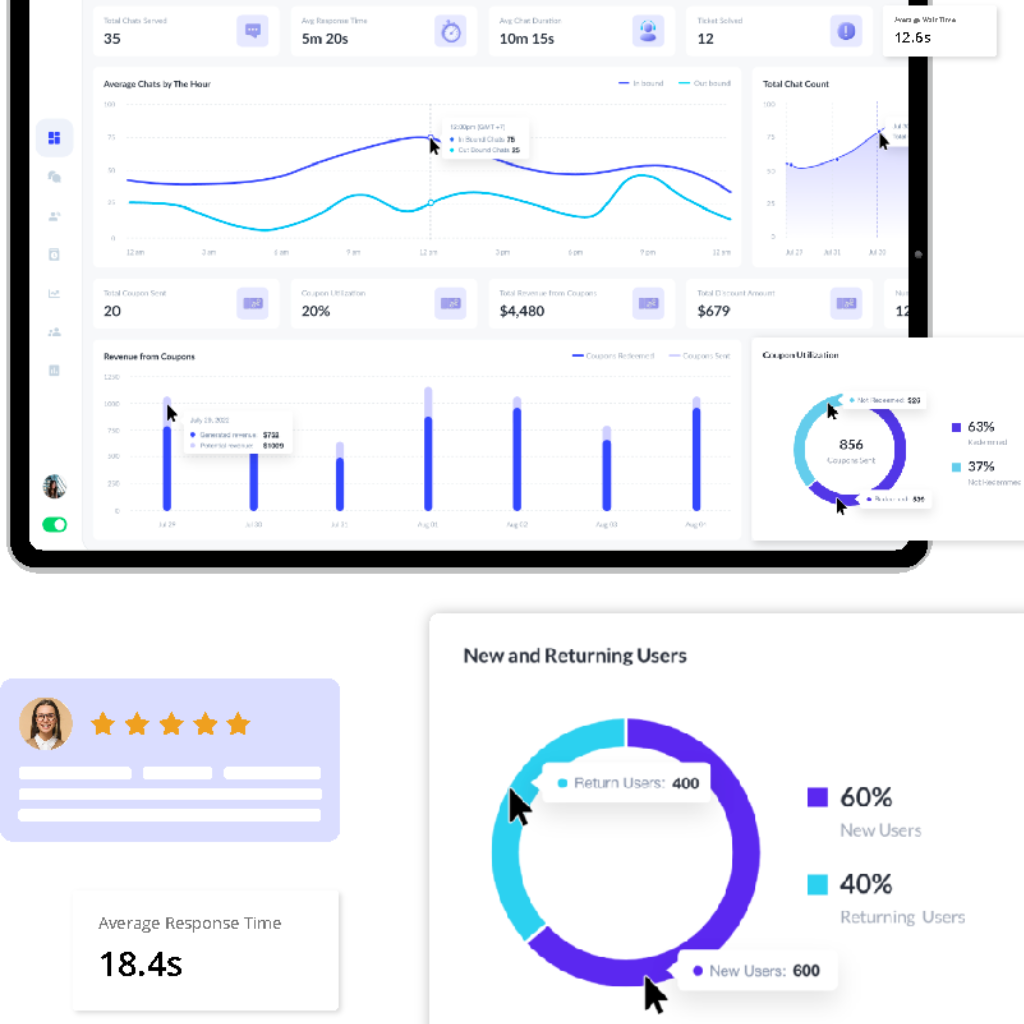As customer expectations continue to rise, companies are under increasing pressure to provide efficient, effective, and satisfying interactions. This is where customer service metrics come into play.
They act as invaluable metrics that guide businesses toward exceeding customer demands. In this article, we’ll explore the 6 must-track customer service metrics.
Let’s get started.
What are customer service metrics?
Customer service metrics are tools that businesses use to measure and evaluate the effectiveness of their customer support efforts.
These metrics provide data-driven insights into various aspects of customer service performance, helping companies identify strengths and areas that require improvement.
The metrics are just like how a dashboard in a car displays important information about the vehicle’s performance.
Customer service metrics give businesses a clear view of how well they’re serving their customers and where adjustments might be needed.
The 6 must-track customer service metrics
Agent utilization
In the fast-paced world of ecommerce, your support team is like the engine propelling your business forward. Agent utilization serves as a powerful gauge of this engine’s efficiency.
It goes beyond counting staff—it measures how effectively your support agents are handling customer interactions.
Understanding agent utilization helps you manage staffing levels during peak shopping seasons.
It also ensures that your customers receive timely assistance without enduring long wait times, translating to higher customer satisfaction and repeat business.
What to do with agent utilization data?
Optimize staffing: Use data on peak activity times to strategically allocate agents, ensuring that your support team is adequately staffed during high-demand periods.
Improve efficiency: Identify underutilized agents and redistribute workloads to maximize productivity and reduce wait times.
Plan training: Determine training needs based on agent performance and areas requiring improvement, ensuring your team is well-equipped to handle various customer inquiries.
How to calculate agent utilization?
Agent utilization = (Total time agents are handling interactions / Total available time) × 100
Total time agents are handling interactions: Sum of the time each agent spends actively assisting customers.
Total available time: Total time the agents were available to handle interactions.
Tip - Prioritize Peak Periods
Identify your busiest hours by analyzing historical data and align agent schedules to match these peak periods.
By ensuring that more agents are available when customer demand is high, you can minimize wait times and deliver prompt support, leading to greater customer satisfaction.

Activity breakdown
Picture your ecommerce customer support operation as a symphony—each agent playing a distinct role in creating a unified experience for your customers.
The activity breakdown customer service metric provides you with a detailed scorecard of these roles, giving you a view of the variety of tasks your agents are performing.
By analyzing these activities, ecommerce businesses can fine-tune their workflow processes, allocate resources more effectively, and ensure that their customers experience smooth, hassle-free shopping journeys.
What to do with activity breakdown data?
Refine support processes: Analyze the distribution of agent activities to streamline workflows, allocate resources effectively, and enhance the efficiency of your support operations.
Enhance training: Identify common tasks and areas where agents might need additional training, enabling you to address knowledge gaps and improve overall performance.
How to calculate activity breakdown?
This customer service metric involves categorizing agent activities based on predefined tasks and measuring the time spent on each category.
Tip - Fine-tune specialization
Analyze activity breakdown data to identify specific areas where agents excel. Create specialized teams based on these strengths, allowing agents to focus on what they do best.
Specialization enhances efficiency and expertise, leading to quicker issue resolution and improved customer experiences.
CSAT (Average satisfaction rate)
Customer satisfaction is the cornerstone of ecommerce success. It can make or break a business.
The CSAT customer service metric, or the average satisfaction rate, measures the level of satisfaction among customers who have interacted with your ecommerce support team.
This metric provides a glimpse into how effectively your support aligns with customer expectations.
High CSAT scores reflect positive shopping experiences, indicating that your ecommerce support plays a pivotal role in encouraging repeat purchases and building brand loyalty.
What to do with CSAT data?
Identify pain points: Dive into customer feedback to pinpoint specific pain points and areas where improvements are needed in your products, services, or support processes.
Benchmark performance: Compare CSAT scores over time to track the impact of changes and improvements, allowing you to gauge the effectiveness of your customer service initiatives.
How to calculate CSAT?
CSAT = (Sum of satisfied responses / Total number of responses) × 100
Sum of satisfied responses: Count of responses where customers indicated satisfaction.
Total number of responses: Total number of customer responses collected.
Tip - Listen to customers
Actively listen to customer feedback provided through CSAT surveys. Regularly review comments and identify recurring themes or pain points.
Use this valuable feedback to continuously refine your support processes and make targeted improvements that resonate with your customers.

Average chat duration
The average chat duration measures the time your agents spend engaged in chat interactions with customers.
It ensures that your online shoppers receive quick resolutions while giving your agents sufficient time to deliver personalized support.
This customer service metric serves as a critical indicator of your ability to address customer concerns without compromising on the quality of assistance provided.
What to do with average chat duration data?
Enhance response strategies: Optimize chat scripts and agent training to ensure that interactions are both efficient and provide comprehensive solutions, contributing to quicker issue resolution.
Offer personalized support: Utilize longer chat durations to deliver personalized assistance, making customers feel valued and increasing the likelihood of repeat business.
How to calculate the average chat duration?
Average chat duration = (Total chat duration / Total number of chats)
Total chat duration: Sum of the time spent in all chat interactions.
Total number of chats: Number of chat interactions.
Tip - Empower with knowledge
Provide agents with access to a robust knowledge base that contains detailed information about products and common issues.
Knowledgeable agents can address queries quickly, reducing chat duration while delivering accurate and helpful solutions to customers.
Average waiting time
The average waiting time metric directly addresses this critical aspect by measuring the time customers spend waiting for their initial response.
For ecommerce businesses, minimizing waiting times is crucial to streamlining checkout lanes.
It enhances the overall customer experience, conveys your commitment to rapid issue resolution, and contributes to the conversion of casual browsers into satisfied buyers.
What to do with average waiting time data?
Optimize workflows: Analyze waiting times to adjust staffing levels and streamline processes, reducing customer wait times and enhancing overall satisfaction.
Implement real-time alerts: Set up alerts for extended waiting times, enabling your team to prioritize urgent inquiries and provide timely responses.
How to calculate the average waiting time?
Average waiting time = (Total waiting time / Total number of chats)
Total waiting time: Sum of time customers spent waiting for their first response.
Total number of chats: Number of chat interactions.
Tip - Set realistic expectations
Implement an automated response system that informs customers about their position in the queue and provides an estimated wait time.
Transparent communication manages customer expectations, reducing frustration during peak periods and creating a more positive support experience.

Total inbound/outbound chats
The total inbound and outbound chat customer service metric provides a full overview of customers sending requests and agents responding to those requests.
Ecommerce businesses can leverage this metric to tailor communication strategies, anticipate customer needs, and provide proactive assistance at pivotal moments in the shopping journey.
By doing so, you enhance the overall customer experience, elevate satisfaction levels, and ultimately drive conversions.
What to do with total inbound/outbound chats data?
Proactive engagement: Leverage insights from proactive chat initiations to identify opportunities for enhancing customer engagement and driving conversions during critical stages of the shopping journey.
Personalize outreach: Use data on customer-initiated chats to tailor proactive outreach efforts, addressing common concerns and providing targeted assistance.
How to calculate total inbound/outbound chats?
Total inbound chats (Reactive) = Total number of customer-initiated chats
Total outbound chats (Proactive) = Total number of agent-initiated chats
Tip - Strategic proactive engagement
Utilize proactive chat based on customer behaviour patterns.
For instance, if a customer spends a significant amount of time on a particular product page, initiate a chat offering assistance or additional information.
Strategic proactive engagement can drive conversions and increase customer engagement.
How to track customer service metrics?
Delivering exceptional customer service is a necessity in today’s world for businesses.
By knowing these 6 metrics we mentioned above you can continue to meet and exceed customer expectations to have your business stand out.
The best way to track customer service metrics is by having a system that does it all for you. This is where Chatso comes in.
Chatso is a human-powered, AI customer service solution. It allows you to proactively interact with customers and provide support throughout their whole online experience.

But Chatso, also leverages data by giving you access to all 6 must-have customer service metrics in one dashboard.
- Agent utilization
- Activity breakdown
- CSAT (Average satisfaction rate)
- Average chat duration
- Average waiting time
- Total inbound/outbound chats

